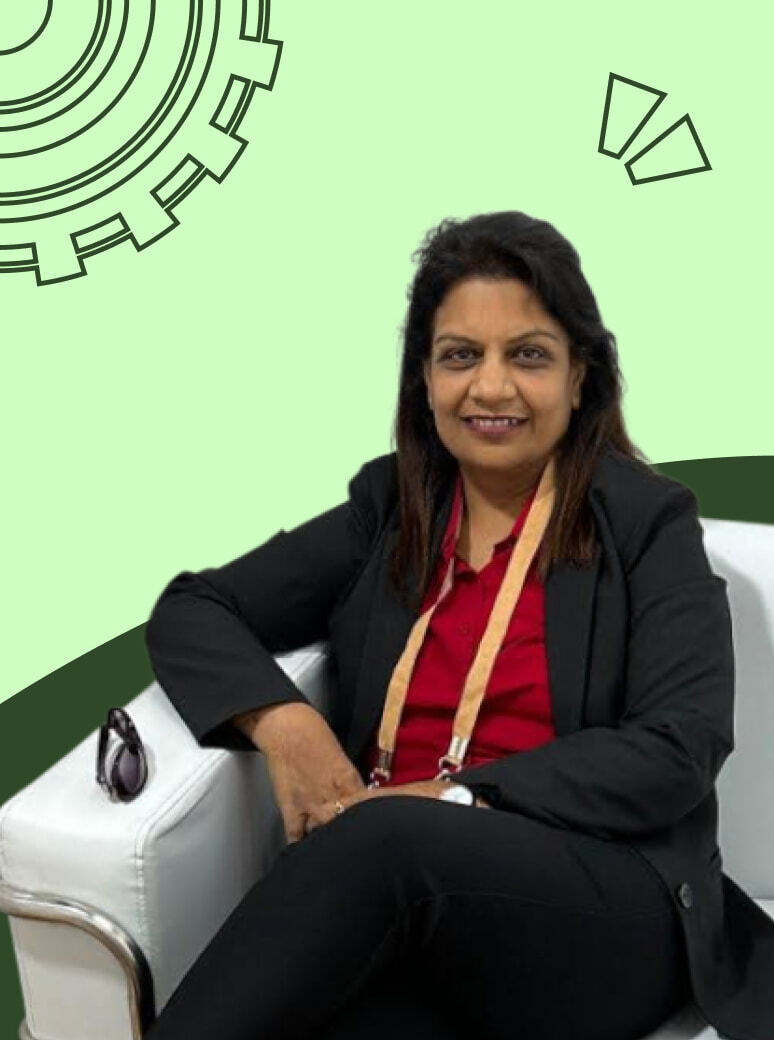Breaking Barriers — Arundhati Shinde’s 35-Year Journey in Manufacturing Leadership

Breaking Barriers: Arundhati Shinde’s 35-Year Journey in Manufacturing Leadership
In 1990, when most young women were encouraged to take up “safe” professions, Arundhati Shinde chose something different. Armed with a degree in electronics engineering, she stepped into the world of manufacturing — a sector where female faces were rare, and resistance was common.
Three and a half decades later, she is the Vice President of Sales & Marketing at Clariant Power Systems Limited, leading some big-value single projects worth up to ₹45 crores, managing a 20-member team, and traveling across India to meet some of the country’s biggest industrial clients. Her journey is proof that resilience, integrity, and continuous learning can break through even the toughest barriers.
Starting Out: Engineering Against the Odds
When Arundhati began her career at DB Electronics (later acquired by Emerson) in 1990, she was entering a world largely closed off to women. Manufacturing floors were dominated by men, and the idea of a woman engineer in electronics was often met with scepticism.
But her parents had instilled in her two values early on: independence and integrity. Even as societal norms resisted her choices, she pressed forward. Those first years taught her to hold her ground, deliver results, and earn respect through competence.
Her career path took her through multiple technical roles before moving into sales and marketing leadership. In 2007, after 17 years in the industry, she pursued an MBA in Finance, adding financial expertise to her technical background. That combination became her edge — enabling her to evaluate projects not just from an engineering standpoint, but also from a business and financial perspective.
Leading at Clariant: A Blend of Tech, Finance, and People
For the past 10+ years, Arundhati has been at Clariant Power Systems, where she leads the sales and marketing division. Her role is as demanding as it is impactful:
- Managing a team of 20 direct reports.
- Overseeing projects ranging from ₹3 crores to ₹45 crores.
- Leading solutions for major clients like Thermax, Adani, Shapoorji Pallonji, Reliance, L&T, Ultratech Cements Ltd, Siemens, and many more.
- Traveling across India to build client relationships and ensure delivery.
Her leadership philosophy is solution-driven. Rather than pushing products, she insists on customized solutions — starting with detailed electrical analysis, then recommending solutions for power quality improvement involving harmonic mitigation and power factor improvement.
The process involves using advanced software like PSCAD and ETAP. Her team carries out simulations before execution, ensuring accuracy and efficiency of physical installations.
This approach has led to milestone projects, including a ₹45 crore solution for Adani’s solar plant at Khavda, a project aligned with India’s national green energy initiatives.
Witnessing 35 Years of Industry Evolution
Arundhati’s career spans a period of extraordinary transformation in manufacturing:
- In the early 1990s, offices ran on fax machines and paper files; today, her teams use ERP and CRM systems for real-time efficiency.
- Decision cycles that once took weeks or months now happen in hours, thanks to digitization.
- SCADA systems enable real-time monitoring of installed panels — a shift not very common when she started.
At Clariant, the technology stack is modern and comprehensive: ERP, CRM, PSCAD, and ETAP software drive simulations and analysis, while AI assists in data analysis and capacity recommendations. Even the factory floor has moved toward partial automation, optimizing capacitors and related components manufacturing.
Her take on AI is pragmatic: it’s not a bubble but a complement. She predicts fully automated factories within 10 years but maintains that human judgment will always remain central to manufacturing.
Breaking Gender Barriers
One of the most inspiring aspects of Arundhati’s journey is her perseverance in an industry where women are still underrepresented.
In her early years, leading male subordinates and earning client confidence wasn’t easy. She often found herself the only woman on the shop floor or in the conference hall, yet she leaned on her engineering expertise and results to silence doubts.
Her message to women in manufacturing is clear:
- Manufacturing is full of opportunities; it teaches discipline, problem-solving, and leadership skills.
- Maintain values and integrity. Respect follows consistency and principles.
- Be a good team player. Collaboration wins more battles than confrontation.
- Embrace problem-solving. Manufacturing is about overcoming challenges with ingenuity.
- Find satisfaction in impact. Unlike abstract work, manufacturing offers visible, tangible results.
Today, she stands as a role model for younger women entering the sector, proving that the barriers, while real, can be overcome.
Managing Today’s Workforce
Arundhati also brings sharp insights into managing the Gen Z workforce. She admires their quick adaptability to technology but notes that their high energy needs to be appropriately focused.
Her approach balances freedom with supervision: give them autonomy to innovate but provide the guidance that ensures accountability.
For her, leadership is not about command and control, but about creating ownership and responsibility.
Lessons for Young Professionals
Looking back on her 35-year journey, Arundhati distills her advice into a few principles:
- Trust your instincts. Take calculated risks, especially early in your career.
- Commit to continuous learning. Whether it’s pursuing higher education mid-career or keeping up with technology, growth requires constant upskilling.
- Work consistently. There are no shortcuts to success; results come from persistence.
- Respect manufacturing. Core manufacturing offers unique job satisfaction because the results are visible and impactful.
For women, she adds: “Don’t be afraid of challenges. Manufacturing will test you, but it will also reward you with tangible, lasting achievements.”
Why Her Story Matters
In India’s manufacturing narrative, names like Arundhati Shinde are crucial. She represents a generation that bridged the old and the new — from fax machines to AI-driven factories, from male-dominated workplaces to inclusive leadership.
Her journey isn’t just about personal success. It’s about opening doors for others, proving that women can thrive in core industries, and showing that manufacturing offers rich, meaningful careers for those willing to put in the work.
Closing Thought
From starting as one of the few women in electronics engineering in 1990 to leading multimillion-rupee projects in 2025, Arundhati Shinde’s story is one of resilience, adaptability, and leadership.
She has broken barriers, built teams, and embraced technology — all while staying rooted in the values her parents taught her: independence and integrity.
For young professionals, especially women, her story carries a powerful message: you can succeed in manufacturing/core industry, not by conforming, but by leading with authenticity, hard work, and vision. Stay committed to yourself and your work, and success follows.
And as India moves towards a future of automated factories and green energy projects, leaders like Arundhati remind us that progress isn’t just about machines or systems — it’s about people who have the courage to pioneer against the odds.
Recent Stories

At the Intersection of Engineering, Manufacturing, and India's growing HVAC/Built Environment sector: Nisha Anil Nair

Made in India, for the World: Pritesh Shah's Journey of Innovation, Resilience, and Purpose
